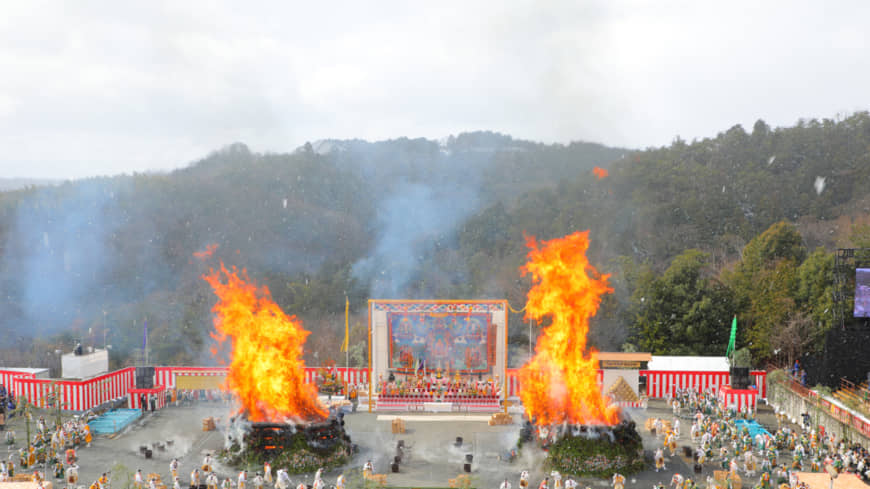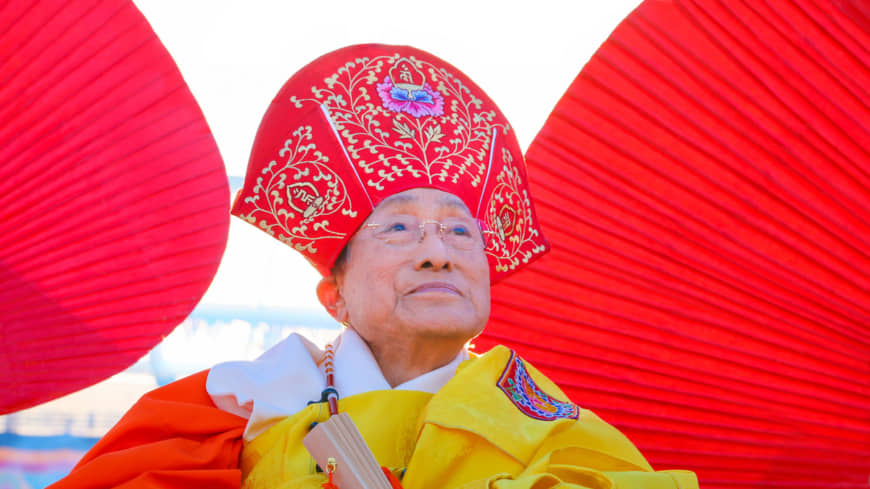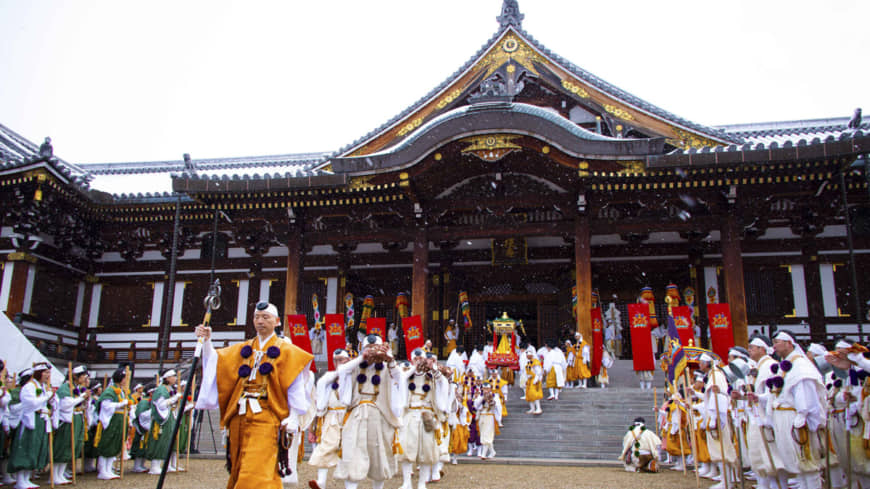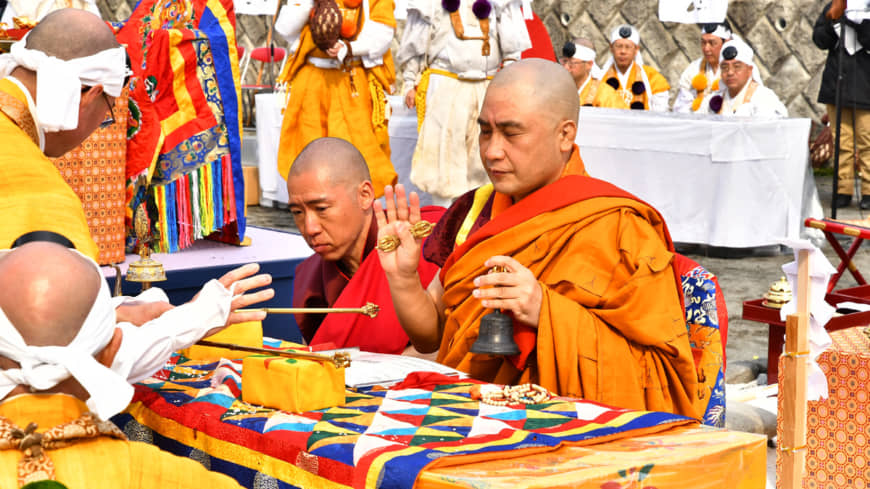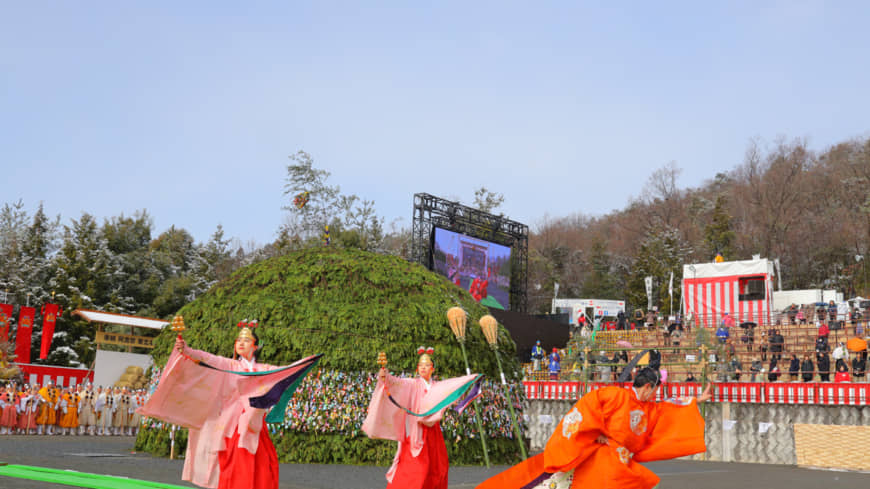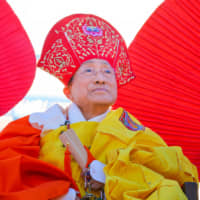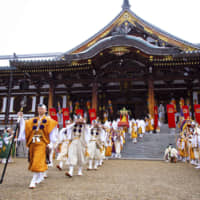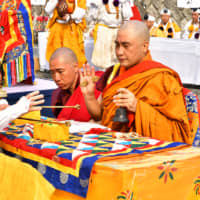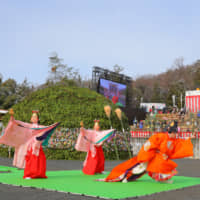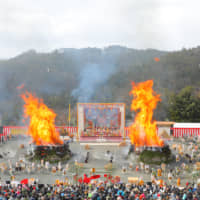French poet Francois Villon once asked, “Where are the snows of yesteryear?” as he pondered the evanescence of existence. The thousands of people who made their way along the winding mountain road to the Agon Shu Buddhist Association’s Fire Rites Festival on the morning of Feb. 9 may have been thinking on similar lines, as they watched the snow form a delicate tracery on the trees, while remembering the Buddha’s message of the impermanent nature of the world.
The Agon Shu faithful and visitors attending the annual event in Kyoto endured the morning cold as the snow fell, but they knew that the world’s biggest fire rites festival would soon fill them with both physical and spiritual warmth.
The themes of this year’s festival were “earthquake safety,” “disaster prevention” and “recovery from natural disasters.” This reflects a series of natural calamities that struck Japan last year. As in past years, 380,000 people attending this year’s Fire Rites Festival prayed to the Lord Buddha and the deities of Japan’s indigenous Shinto religion for world peace.
Search for truth
The late Reverend Seiyu Kiriyama founded Agon Shu in 1978 after a long search for spiritual truth. He found it in the Agama Sutras, the original and purest Buddhist scriptures. The Lord Buddha is the ultimate object of worship for Agon Shu believers, in addition to the dharma — the Buddha’s teachings and training methods. They rely on the sangha — the community of priests dedicated to the Buddha and dharma. The main purpose of the Fire Rites Festival is for world peace and praying for its realization gives spiritual aid and comfort to the souls of the departed, and helps the living move forward on the path toward self-realization.
Agon Shu is now a community of Buddhist followers with 76 institutions in Japan and six facilities abroad, 150 priests, nearly half a million believers in Japan, and thousands more overseas.
Fireworks light cloudy sky
The festival began with a bang — literally — as multicolored fireworks burst in the sky. Their bright colors offset the thick white snowflakes that cascaded from the overcast sky. As always, the event’s rituals were carried out with almost military precision, with everything methodically planned down to the last second and detail.
A procession of Agon Shu members dressed as yamabushi mountain priests then entered the amphitheater to the sounds of dramatic music by the late composer Toshiro Mayuzumi. Some blew on conch shells, while others carried a palanquin bearing Kiriyama’s sacred ashes, which were reverently placed at the center of the huge, elaborately decorated altar on one side of the amphitheater.
The Agon Shu yamabushi formed orderly ranks around the two gomadan pyres at the center of the amphitheater where the rituals are performed. One pyre is called the bukkaidan, for the liberation of the spirits of the departed, while the other is the shinkaidan, for the prayers, requests and desires of the living.
Before the bonfires were lit, a series of sacred rituals were held to ensure the success of the day’s proceedings. Three dancers — two female and one male — wearing holy costumes reminiscent of ancient, brightly colored court costumes entranced onlookers as they performed stately bugaku dance rituals to the haunting sound of neo-gagaku imperial court music by gagaku musician Hideki Togi.
Spiritual cleansing, renewal
Five men wielding ritual long-handled axes standing at the four corners of the ceremonial area in the center of the amphitheater performed a purification ritual, slashing boldly through the air with their axes. Six female archers then shot wooden, blunt-tipped arrows out of the amphitheater as part of the process of spiritual cleansing and renewal.
After a mondō question-and-answer exchange concerning Agon Shu’s Shugendo (an ancient mountain religion native to Japan) doctrine that was carried out by several of the yamabushi-clad faithful, four huge torches were lit with sacred fire. Attendants inserted them into the base of the gomadan pyres, and gray smoke soon began to emerge from the pyres, in thick, billowing columns that spiraled upward into the sky. It wasn’t long before bright orange flames burst out of the pyres.
No matter how many times one has attended the Fire Rites Festival, the excitement and awe a person feels when they see the pyres begin to burn in bright tongues of flame are always the same — it’s truly spectacular. The heat emitted by the pyres filled the amphitheater, dispelling the morning’s wintry gloom.
Attendants began throwing gomagi prayer sticks, on which believers write their personal prayers and desires, into the flaming pyres. A total of 29 million gomagi were burned in this year’s festival.
Joy and celebration
Although the Fire Rites Festival has a very serious purpose, it’s also a joyous, celebratory occasion. There’s a carnival-like atmosphere, with Agon Shu faithful serving as attendants calling out and urging people to purchase gomagi prayer sticks, as well as various souvenirs and religious articles. The festive mood is especially apparent at the small stage where people dressed in colorful costumes dance with an Agon Shu member dressed as Daikoku, the god of wealth.
Agon Shu continues to be very active outside Japan. The association has held Fire Rites ceremonies in various parts of the world, including the Solomon Islands, Papua New Guinea, Jerusalem, Auschwitz and Siberia. This year, it is planning to hold special events in Taiwan, Thailand and Singapore.
Agon Shu has also announced plans to construct a building in the style of a Japanese temple in Israel in 2021. It promises to be quite an undertaking. The wooden structure will first be built in Japan using methods of traditional carpentry used in temple and shrine construction before being disassembled and shipped to Israel, where it will be reassembled and dedicated in a special ceremony.
For more information on the Fire Rites Festival, visit https://www.agon.org/hoshimatsuri/e/.
Festival leaves lasting impression on visitors
People from all over the world visit the Fire Rites Festival every year. And they never cease to be impressed.
“It’s amazing — I don’t feel like I’m in Japan,” said Norina Deuerling from Austria. “I have been in religious places like India. I didn’t know this (side of) Japan.”
Trulku Rainchennangay, the head of a Buddhist monastery in Bhutan, said he enjoyed seeing a snowfall in Japan and felt the atmosphere of the festival was authentically Buddhist.
“I find it very interesting because I’m from the United States, and we don’t have any ancient cultural practices,” said Jonathan Bartley, a tourist from Boston.
“It’s a marvelous event,” said Medagoda Abhayatissa, a Buddhist monk from Sri Lanka who was attending the festival for the third time. “I think the priests and the devotees practice the fire festival very faithfully. It gives a lot of energy to society.”



